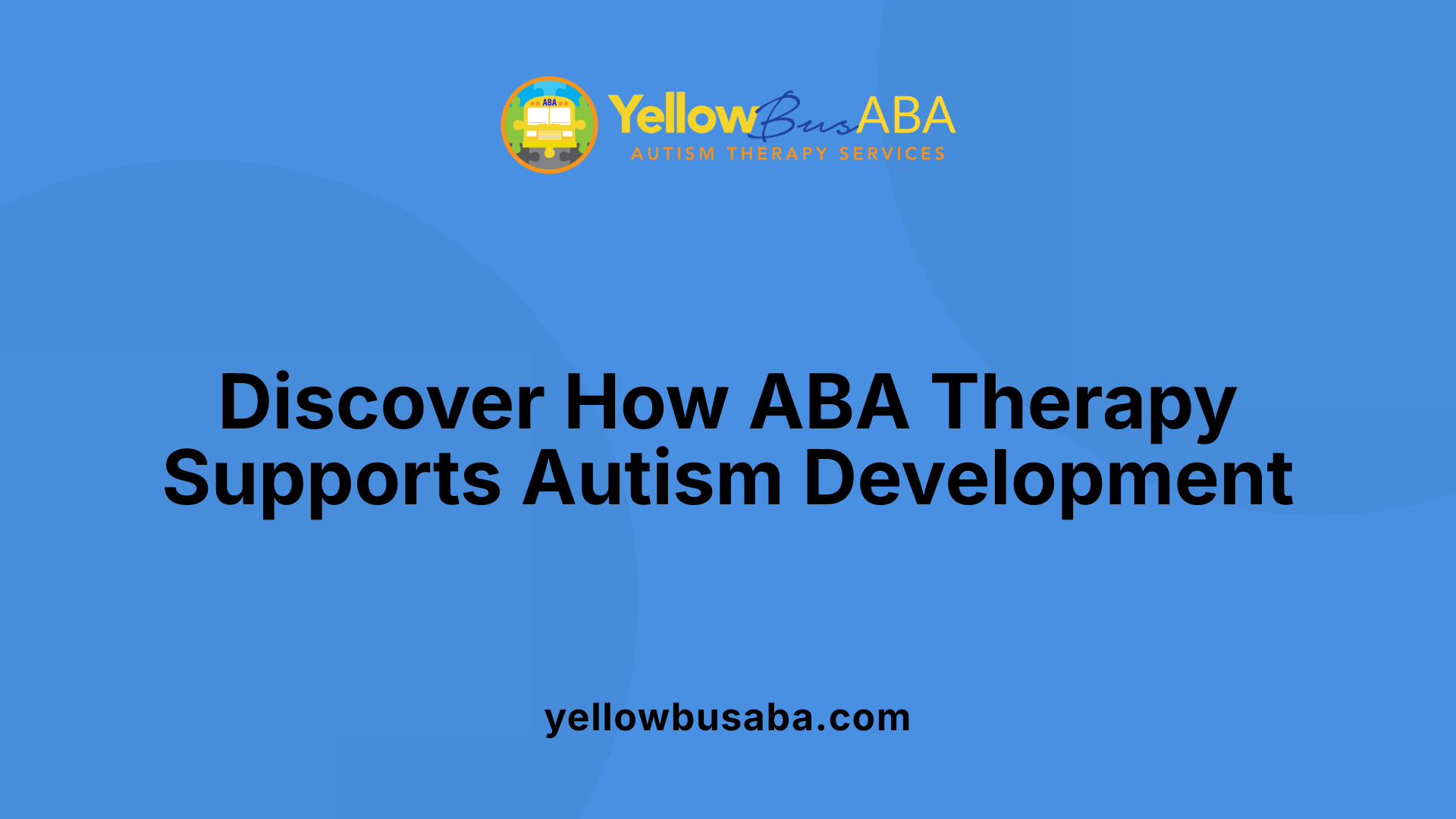How ABA Therapy Improves Self-Control and Behavioral Flexibility in Children
October 29, 2025
Unlocking Potential: ABA Therapy's Role in Enhancing Self-Regulation and Adaptability in Children

Understanding ABA Therapy and Its Impact on Behavior
Applied Behavior Analysis (ABA) therapy has become a cornerstone intervention for children with autism spectrum disorder, focusing on enhancing self-control and behavioral flexibility. Through evidence-based and individualized strategies, ABA supports children in managing challenging behaviors, improving communication, and adapting to changes in their environment. This article explores how ABA therapy empowers children to develop critical skills for independence and inclusion, highlighting its methodologies, goals, and practical applications.
What is ABA Therapy and Its Role in Autism Support?

What is Applied Behavior Analysis (ABA) therapy and how does it help individuals with autism?
Applied Behavior Analysis (ABA) therapy is a science-based approach designed to assist individuals with autism spectrum disorder (ASD) in developing essential skills and reducing challenging behaviors. Grounded in the principles of behavior and learning, ABA uses personalized, data-driven strategies tailored by qualified professionals like Board Certified Behavior Analysts (BCBAs).
Core objectives of ABA in autism treatment
ABA focuses on enhancing communication, social skills, self-care, play, motor skills, and independence. It aims to increase adaptability and behavioral flexibility while managing anxiety. By building foundational skills, ABA helps individuals participate more fully in society and promotes joy and independence rather than mere compliance.
Techniques used in ABA therapy
Common strategies include positive reinforcement, prompting, role-playing, visual supports, social stories, and functional communication training. These techniques help break down complex skills into manageable steps, with successes rewarded to encourage repetition. Data collection ensures that therapy is adapted continuously to meet individual progress.
The benefits of early intensive intervention
Starting ABA therapy early, often before ages 3 to 6, has shown significant benefits, especially for children at risk of delayed verbal communication. Early intensive behavioral interventions facilitate substantial improvements in language, intellectual abilities, social interaction, and daily living skills within weeks of consistent practice, particularly with strong home involvement.
In summary, ABA therapy offers a scientifically supported, personalized pathway to improve skills and reduce behaviors that may interfere with learning and social participation, making it a cornerstone of autism support.
Key Providers in ABA Therapy: Who Delivers the Intervention?

Who typically provides ABA therapy for individuals with autism?
ABA therapy is delivered by a team of trained professionals working under the guidance of a Board Certified Behavior Analyst (BCBA). The BCBA is a licensed expert who designs and oversees individualized treatment plans tailored to each child's unique needs. They ensure the therapy is evidence-based and data-driven.
Roles of Board Certified Behavior Analysts (BCBA)
BCBAs are responsible for developing assessment plans, setting measurable goals, training therapy staff, and monitoring progress. They provide supervision and lead ongoing adjustments to maximize the effectiveness of interventions.
Therapists and behavior technicians
Therapists and Registered Behavior Technicians (RBTs) directly implement ABA strategies during sessions. They conduct structured activities, collect data on behaviors, and apply positive reinforcement techniques as directed by the BCBA.
Settings where ABA is delivered
ABA services can be provided in multiple environments such as clinics, the child's home, schools, or community locations. This variety helps in generalizing skills across different contexts and promotes natural learning opportunities.
Importance of qualified and trained providers
Choosing providers with proper certification and specialized training is crucial. Qualified professionals ensure ethical, effective, and safe interventions that respect the individual needs of the child.
Role of parents and caregivers in therapy support
Parents and caregivers are key collaborators in ABA therapy. They receive coaching from professionals to reinforce learning at home and help maintain consistency. Their active participation supports generalization and fosters positive outcomes.
This team-based approach ensures that children with autism receive personalized support that promotes independence, social skills, and behavior management in a compassionate environment.
Primary Goals of ABA Therapy in Enhancing Self-Control and Flexibility

What are the primary goals of ABA therapy in autism treatment?
ABA therapy focuses on improving multiple areas critical to a child's development and daily functioning. Its primary goals include enhancing communication and social skills, which helps children better interact with others and express their needs. Alongside this, ABA targets daily living skills such as dressing, grooming, and hygiene to promote greater independence.
Additionally, ABA works to reduce problematic and challenging behaviors like tantrums or self-injury. This is achieved by identifying behavior triggers and teaching safer, more appropriate alternatives. Each therapy plan is highly individualized, tailored to the unique strengths and challenges of the child. Professionals use comprehensive assessments and input from caregivers to set goals that match developmental levels and personal needs.
Positive reinforcement is a core principle of ABA, where desired behaviors are rewarded to encourage repetition. This encouragement helps children connect their actions to positive outcomes, fostering behavioral flexibility and self-control. Therapists continuously monitor progress by collecting data, which informs regular adjustments to the treatment plan, ensuring it remains effective and relevant.
Through these combined methods, ABA therapy helps children with autism build adaptability, reduce anxiety around change, and develop skills that significantly improve their quality of life and participation in their communities.
Techniques and Strategies That Foster Behavioral Flexibility

Visual supports and social stories
ABA therapy uses visual supports and social stories to help children understand and anticipate changes, making transitions smoother. These tools break down complex situations into clear, manageable steps, reducing anxiety and enhancing comprehension.
Gradual exposure and role-playing
Gradual exposure gently introduces children to new experiences or routines incrementally, building tolerance and confidence. Role-playing allows them to practice social scenarios in a safe environment, fostering adaptability and preparing them for real-life interactions.
Use of calming tools and functional communication training
Calming tools such as sensory items or relaxation techniques are incorporated to help children manage stress or sensory overload. Functional communication training teaches alternative, effective ways to express needs and emotions, which reduces frustration and supports behavioral flexibility.
Naturalistic and play-based learning environments
Modern ABA emphasizes learning in natural, playful settings that engage children’s interests. This approach facilitates generalization of skills, ensuring that behaviors learned during therapy transfer to everyday situations, promoting more flexible responses.
Moving away from aversive punishments
Contemporary ABA strategies have shifted away from aversive punishments. Instead, they focus on positive reinforcement and supportive methods that respect the child’s emotional well-being while encouraging adaptive behaviors and independence.
Data-Driven Personalized Interventions and Progress Tracking

Breaking down skills into small steps
ABA therapy utilizes a highly systematic approach where complex skills are divided into smaller, manageable steps. This technique allows children with autism to learn incrementally and build mastery gradually. Each step is clearly defined and taught through repeated practice, ensuring the child can successfully achieve one objective before moving on to the next.
Positive reinforcement and reward systems
Central to ABA is the use of positive reinforcement, which involves rewarding desired behaviors to encourage their recurrence. Rewards can include tokens, small prizes, or verbal praise. This system motivates children to practice and adopt new skills by associating success with positive outcomes.
Continuous data collection and adjustment of plans
ABA therapy is data-driven, involving constant monitoring of a child's performance. Practitioners collect detailed data on progress, which informs ongoing adjustments to treatment plans. This continuous feedback loop ensures interventions remain effective and are tailored according to the child's evolving needs.
Early Intensive Behavioral Intervention (EIBI) and other evidence-based models
Several evidence-based ABA interventions, such as Early Intensive Behavioral Intervention (EIBI), Natural Environment Teaching (NET), and Pivotal Response Treatment (PRT), are incorporated depending on individual goals. These models emphasize early application, with EIBI especially targeting young children to maximize developmental gains.
Tailoring therapy to communication abilities including non-verbal children
ABA techniques are adaptable to children at varying developmental stages, including those who are non-verbal. Visual supports, social stories, and communication devices are integrated to support understanding and expression. This personalization enables therapy to effectively address unique communication challenges while promoting skill acquisition and behavioral flexibility.
Managing Challenging Behaviors through ABA Techniques
Understanding Behavior Triggers
ABA therapy begins by identifying specific triggers that lead to challenging behaviors in children with autism. Recognizing these antecedents allows therapists to address root causes rather than just symptoms. This understanding facilitates targeted interventions that help children anticipate and manage situations that may provoke negative behaviors.
Teaching Safer Alternatives and Self-Regulation
Once triggers are identified, ABA techniques focus on teaching safer, alternative behaviors. For example, children learn functional communication skills to express needs instead of resorting to tantrums or self-injury. Self-management plans involve goal-setting, environmental adjustments, and behavior logging, encouraging children to monitor and regulate their own actions with decreasing adult guidance.
Use of Reinforcement to Reduce Problematic Behaviors
Positive reinforcement is central to ABA’s approach for behavior management. Desired behaviors such as staying seated during meals or using calm communication are rewarded through tokens, praise, or small prizes, encouraging repetition. This method effectively reduces difficult behaviors like tantrums, yelling, or self-harm by reinforcing socially acceptable responses to various situations.
Involving Families and Caregivers in Behavior Management
Families play a vital role in extending ABA’s benefits beyond therapy sessions. Caregivers receive training to apply ABA principles at home, reinforcing progress and consistency. This collaboration ensures children experience supportive environments across settings, enhancing generalization of learned skills and promoting continuous growth.
ABA’s Role in Promoting Independence and Societal Participation
ABA therapy not only reduces challenging behaviors but also fosters independence and community involvement. By teaching self-regulation and adaptive coping strategies, children with autism gain confidence to participate fully in social and educational environments. The ultimate aim is to empower individuals to thrive in society while honoring their unique needs and strengths.
Promoting Self-Management and Independence in Children with Autism
What are self-management plans and goal setting in ABA therapy?
Self-management plans in ABA therapy are designed to teach children with autism how to regulate their own behaviors and develop social skills independently. The process begins with identifying clear, achievable goals that the child can work towards. This structured approach encourages children to take ownership of their progress and enhances their motivation.
How is the environment modified and behavior logged?
Environmental modification plays a crucial role by arranging settings in ways that support the child's goals and make desired behaviors easier to achieve. Concurrently, maintaining a detailed log of behaviors allows both therapists and learners to track progress, recognize patterns, and make informed adjustments to strategies. This data-driven method ensures therapy is personalized and effective.
In what ways is the learner actively involved in implementing strategies?
Children are not passive recipients but active participants in their therapy. They engage in recording their behaviors, applying learned coping mechanisms, and practicing social skills. This involvement fosters independence and confidence, helping transition skills from the therapy session to everyday life.
How does the therapist gradually reduce assistance?
Initially, therapists provide strong guidance and instruction to set the foundation. As the child becomes proficient, assistance is carefully and gradually reduced, encouraging autonomy. This fading of support is essential for promoting self-regulation and preparing the child for independent application of skills.
Can you provide examples of self-regulation applications?
A practical example is teaching a child to remain seated during meals. A self-management plan would set this as a goal, include strategies like environmental cues or reinforcement systems such as tokens or small prizes, and involve monitoring adherence throughout mealtime. Over time, the child learns to manage this behavior independently, illustrating the effectiveness of ABA in fostering real-world skills.
This structured yet flexible approach to self-management empowers children with autism, helping them achieve greater independence and confidence in daily activities.
The Broader Impact of ABA Therapy on Social Skills and Community Inclusion
How Does ABA Therapy Improve Social Communication and Peer Interaction?
ABA therapy is highly effective in enhancing social skills among children with autism spectrum disorder (ASD). Through systematic, evidence-based interventions, children demonstrate significant improvements in social communication, peer interactions, and group social skills, often noticeable within months of consistent therapy. Techniques such as social stories, role-playing, and positive reinforcement encourage development of appropriate social behaviors and communication.
Can Learned Skills Through ABA Be Generalized Across Different Settings?
Generalization is a crucial focus of ABA therapy. Interventions are designed so that skills acquired during sessions transfer to various environments, including home, school, and community settings. This ensures that children apply their new abilities broadly, fostering greater independence and confidence in everyday situations.
How Does ABA Support Transitions Through Different Life Stages?
ABA therapy incorporates transition planning to assist individuals with ASD in adapting smoothly to life changes, such as moving from childhood to adolescence or entering the workforce. Tailored strategies and ongoing support help maintain progress while encouraging autonomy during each stage.
In What Ways Does ABA Promote Community Advocacy and Inclusivity?
Beyond individual skill-building, ABA fosters community awareness and inclusivity by promoting understanding and acceptance of people with ASD. Programs emphasize participation in social and community activities, aiming to reduce stigma and support full societal inclusion.
How Does Modern ABA Therapy Foster Joy, Participation, and Personalized Growth?
Current ABA practices prioritize individualized goals centered on the child's strengths and interests. Therapy environments now focus on play-based and naturalistic learning experiences, promoting joy, personal growth, and participation rather than mere compliance. This person-centered approach respects neurodiversity and supports meaningful development.
| Aspect | ABA Focus | Impact |
|---|---|---|
| Social Communication | Systematic skill-building using evidence-based methods | Improved peer interaction and social responsiveness |
| Generalization | Skills transferable across home, school, community | Enhanced adaptability and independence in varied settings |
| Life Stage Transitions | Customized planning and support | Smooth adjustments to developmental and vocational changes |
| Community Advocacy | Promoting awareness and acceptance | Greater societal inclusion and reduced stigma |
| Joy and Personalized Growth | Play-based, strength-focused therapies | Increased engagement, happiness, and individual empowerment |
Empowering Children Through ABA: Building Foundations for Lifelong Self-Regulation and Adaptability
ABA therapy represents a powerful, evidence-based approach that supports children with autism in developing essential skills of self-control and behavioral flexibility. Through personalized, data-driven strategies delivered by qualified professionals, ABA helps alleviate anxiety around change, encourages positive behaviors, and fosters independence in daily living. By prioritizing individualized goals, gentle and naturalistic teaching methods, and active involvement of families, modern ABA emphasizes not only behavioral improvements but also the child's happiness and community inclusion. In doing so, it paves the way for children to navigate complex social environments with greater confidence and adaptability, ultimately enhancing their quality of life and participation in society.
References
- ABA Therapy Techniques to Help Your Child Handle Change
- The Controversy Around ABA
- Applied Behavior Analysis: What Is It and How Does It Work?
- Questions and answers about ABA
- ABA Therapy and the Pursuit of Independence in Daily Life
- What is Self-Management in ABA Therapy?
- The Impact of Applied Behavior Analysis on Children ... - ERIC
- ABA Therapy Goals: 25 Practical Examples & Timelines
- Applied Behavior Analysis (ABA)
- Applied Behavior Analysis (ABA)






